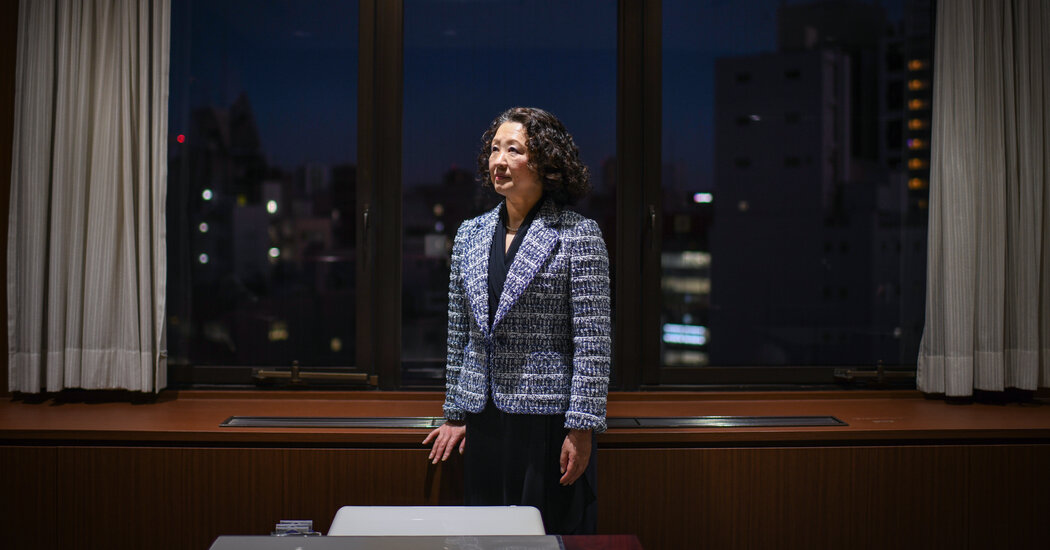
TOKYO — Women have never found a welcoming home in Japan’s labor unions. Sexism is entrenched. Problems like wage discrimination and sexual harassment at work are often ignored. Many women, lacking a voice, have given up on the movement.
So when Japan’s largest association of labor unions, known as Rengo, appointed its first female leader last October, the excitement was tempered with a heavy dose of skepticism.
The new chief, Tomoko Yoshino, knows the feeling well: After decades in the labor movement, she understands the failings of Japanese unions as well as anyone. But she’s confident that she can make her appointment a powerful tool for reform.
“The fact that I want to make gender equality a part of all of Rengo’s activities has gotten a lot of attention,” she said in an interview, adding that it had put pressure on the group’s member organizations to “demonstrate real results.”
Proving that unions can be strong allies to working women is critical for the future of Japan’s once-mighty labor movement, which has largely failed to attract women even as their numbers have rapidly expanded in the country’s work force.
To recruit female workers, unions will need to fight for measures that help women manage both their jobs and the heavy expectations they face outside work, including standing up for women facing sexual harassment and discrimination and pushing companies to provide more help with child care.
Japan has one of the world’s worst records on gender equality, placing 120th out of 156 countries in a ranking by the World Economic Forum, even after years of government promises to help women “shine.”
The country’s unions reflect this imbalance, said Keiko Tani, who helps run a nonprofit dedicated to assisting women navigating workplace issues.
She said women often needed help, for example, after being punished for taking maternity leave. But most unions, she said, still focus on old models of employment that assume a traditional family structure in which the husband works “24 hours a day and leaves housework, child rearing and the other things regarding his personal life to his wife, a professional homemaker.”
In the 1990s, Ms. Tani and her friends became so fed up with the sexism in Japan’s unions that they quit and started their own. She said that while she was cheering for Ms. Yoshino’s success in bringing reform, a lifetime of disappointment with the labor movement had taught her not to get her hopes up.
“Unions are built around men,” she said. “It’s going to be difficult for any leader to break that mold and make new changes.”
Midori Ito, a longtime labor activist, said gender discrimination in unions had been so bad for so long that many women had “completely given up on them.”
She dropped out of the union movement years ago because of frustration with its lack of action on the issues confronting Japanese working women. “They don’t listen to us,” she said.
The problems with Japanese unions don’t end with their treatment of women. While interest in labor groups has surged in the United States in recent years, they have become increasingly marginalized and irrelevant to many Japanese workers, said Kazunari Honda, a professor of human resources management at Mukogawa Women’s University who studies gender in the labor movement.
It wasn’t always that way. From the end of World War II through the 1970s, unions represented over 30 percent of Japanese workers.
But that number began to dwindle as the ’70s energy crisis forced companies to downsize. When economic growth ground to a halt in the 1990s, membership plunged further. Workers, fearing layoffs, became more conservative in their demands, trading gains in pay and working conditions for job stability. Strikes, once a common tactic, largely disappeared.
Today, unions represent just 17 percent of Japan’s work force, making it difficult for them to effect meaningful change.
Feb. 16, 2022, 9:56 a.m. ET
As unions’ influence has waned, another force in Japan’s economy has been on the rise: non-regular workers, who fall outside the country’s traditional model of jobs for life.
Since the 1980s, the number of non-regular workers in Japan has more than doubled, to almost 37 percent from 16 percent — some 20.6 million workers — in 2021. Nearly half are women, who have become disproportionately represented among non-regular employees as the percentage of female workers under 65 rose nearly 20 percent over the last several decades.
Unions have long been reluctant to include non-regular workers because the organizations are focused on protecting the prerogatives of their “regular” counterparts: better benefits and higher salaries. Speaking up for their more dispensable co-workers, the logic goes, would gain them little and put their own amicable relationship with management at risk.
That relationship is an unusual feature of Japanese labor organizations. Most of the groups are organized around a specific company, rather than an industry or a trade, as in the United States. And they tend to work closely with businesses to ensure stable employment, rather than try to force change through dramatic actions like strikes.
For temporary workers, many of whom frequently switch employers, there is little incentive to commit to a group organized around a workplace they may soon leave.
Encouraging those workers to organize, Ms. Yoshino said, will require Rengo — which is known as the Japanese Trade Union Confederation in English and has about seven million members — to invest more in strengthening unions based around industries, not enterprises.
In particular, she believes the group needs to focus on workplaces — such as department stores and supermarkets — that employ large numbers of non-regular, female workers.
Ms. Yoshino, 56, who started work at a sewing machine manufacturer out of high school, said she did not think much about gender discrimination until 1985, when her employer eliminated its pay gap in response to the passage of Japan’s Equal Employment Opportunity Act. The large pay raise she received opened her eyes to how far behind women had been, she said.
As a regular employee, she was automatically added to the manufacturer’s union. Her career as an activist started with a small victory: persuading the union to demand that the company pay for ribbons and belts that were a required part of women’s uniforms. By 1988, she had become the first woman on the 20-member executive committee of the company’s union.
In the following years, as she focused on gender equality, she made her way up the union ranks, eventually landing at Rengo’s Tokyo regional office and then moving to the group’s headquarters, where she was put in charge of a committee on women’s issues.
When Ms. Yoshino was offered the top job at Rengo, she seriously considered turning it down, she said. The organization, a confederation of thousands of unions representing Japan’s largest and most successful companies, is by its very nature conservative and resistant to change. But she ultimately decided that turning down the opportunity would be a betrayal of the many women who had helped her in her own career.
Among those who know her best, Ms. Yoshino has a reputation for being a plain-spoken fighter who gets things done. While most union officials tend to prevaricate, “for good and bad, she says what she thinks,” said Chiaki Saito, who leads Rengo’s Tokyo branch.
“Japanese newspapers are saying that she’s a puppet, but it makes me laugh,” she added. “If someone thinks they can control her, they should give it a shot.”
Ms. Yoshino’s first major test as Rengo’s head will come this spring as Japan’s unions gear up for their annual salary negotiations, called “shunto,” or “spring offensive.”
Prime Minister Fumio Kishida has urged employers to raise wages 3 percent as part of his promise of a “new capitalism” that reduces the country’s growing inequality. The goal is unrealistic, but all eyes will be on Ms. Yoshino regardless.
She may have already estranged one of her biggest potential allies: Japan’s Communist Party, a small political group but a powerful force in the labor movement. Ms. Yoshino has drawn attention for her political views, especially her anti-Communist rhetoric.
The group’s own labor union, Zenroren, is Japan’s second largest. It, too, is led by a woman, Masako Obata, who was appointed in 2020, essentially putting the two women best placed to change Japan’s labor movement at loggerheads.
The groups may not be able to overcome their differences, but even so, having two women leading Japan’s two most powerful unions in a fight for gender equality is bound to produce some results, Ms. Obata said.
“I think we’ll be a powerful force for changing this country’s unchanging politics,” she said.




